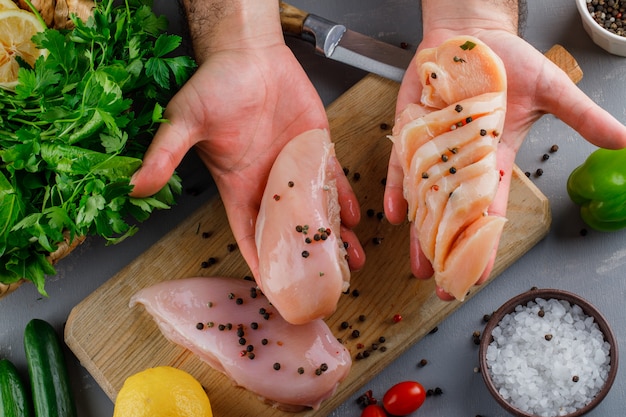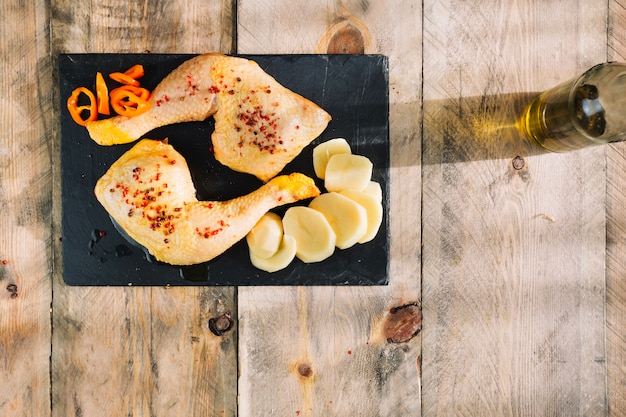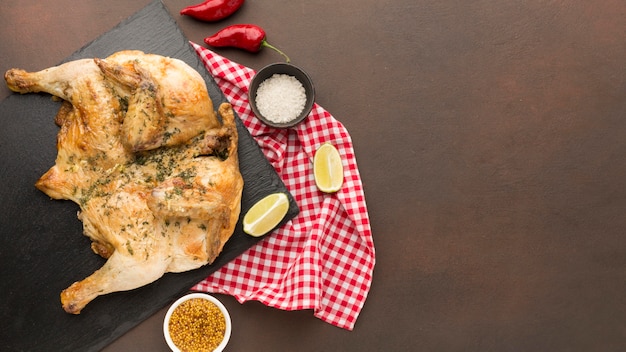chicken breasts – they're the ultimate kitchen chameleon, right? A blank canvas for so many meals, but getting them cooked just right, juicy and tender, can be a bit of a puzzle, especially at 375 degrees. I've definitely had my fair share of those dry, rubbery chicken breasts that make you want to chuck the whole thing in the bin. But trust me, with a little know-how, you can master the art of cooking chicken breast at 375 degrees and conquer those dry bird blues.
In this guide, I'm going to share my personal experiences, the tips and tricks I've learned over time, and some handy cheat sheets to help you nail that perfect chicken breast every time. So grab a pen and paper (or bookmark this page!), and let's get cooking!
(Part 1) Understanding the Basics: Setting the Stage

First things first, let's talk about the fundamentals. cooking chicken breast at 375 degrees is a tried and true method, but it needs a bit more attention than other temperatures. Here's a breakdown of what you need to know:
1. Why 375 Degrees? The Goldilocks Temperature
375 degrees Fahrenheit (or 190 degrees Celsius) is like the Goldilocks temperature for cooking chicken – it's hot enough to cook the chicken thoroughly, ensuring safety and achieving that lovely golden-brown color. But it's not so hot that it dries out quickly. Think of it as a sweet spot where we can achieve that perfect balance of texture and flavor.
2. The juicy chicken Secret: Timing is Everything
Overcooking is the arch-nemesis of a juicy chicken breast. Overcooked chicken becomes dry, tough, and frankly, a bit of a sad sight. That's why timing is critical when cooking at 375 degrees. You want to cook the chicken just until it's no longer pink in the center, but not a moment longer. Think of it as a delicate dance with the oven, a gentle waltz where you need to pay attention to every step.
3. The Versatile Canvas: boneless, skinless chicken breasts
Most recipes call for boneless, skinless chicken breasts, and for good reason. They're incredibly versatile, easy to handle, and cook quickly. They're the blank canvas we were talking about, ready to be transformed into delicious meals. But don't be afraid to explore other options! You can also use bone-in chicken breasts or chicken thighs, just remember to adjust the cooking time accordingly. We'll delve into that in more detail later.
(Part 2) Factors Affecting Cooking Time: The Variables at Play

Here's the thing about chicken breasts: they're not all created equal. Size, thickness, even the breed of the chicken can affect how long it takes to cook. So, there's no one-size-fits-all answer when it comes to cooking time. It's like a puzzle with a few pieces to consider:
1. Thickness: A Matter of Depth
The thicker the chicken breast, the longer it will take to cook. A thin chicken breast, say less than an inch thick, might be done in 15-20 minutes. But a thicker one, maybe 1.5 inches or more, could take 25-30 minutes or even longer. Think of it like a thick book versus a thin pamphlet – it takes longer to read the whole thing!
2. Size: Big Bird or Little Chick?
Similar to thickness, the overall size of your chicken breast plays a role in cooking time. A large breast, like a giant turkey breast, will take longer than a smaller one, like a delicate chicken breast from a young bird. So, keep an eye on the size – a bigger breast means more time in the oven.
3. Oven: The Temperature Tinker
Ovens can vary in temperature – some run a little hotter or colder than others, which can definitely affect the cooking time. It's always a good idea to check your chicken's internal temperature with a meat thermometer. This ensures accuracy and avoids any surprises in the form of undercooked or overcooked chicken.
4. Other Ingredients: A Symphony of Flavors
If you're marinating your chicken or adding other ingredients like vegetables, it can affect the cooking time. Marinades, for example, can help retain moisture, which can extend the cooking time slightly. It's like adding a few instruments to a musical ensemble – each ingredient adds its own layer and can influence the overall cooking time.
(Part 3) How to Tell If Chicken is Done: The Art of the Perfect Doneness

Here's the crucial part: knowing when your chicken breast is cooked through. We want to make sure it's safe to eat, but also not overcooked, so it stays juicy and flavorful. Let's talk about the different methods to ensure your chicken breast is cooked to perfection.
1. The Colour Test: The Visual Cue
The chicken should be white throughout, with no trace of pink. This can be a bit tricky as some chickens have a more yellow hue. So, while color is a good starting point, don't rely on it alone – use a thermometer for the ultimate confirmation.
2. The Touch Test: A Gentle Press
This is a less reliable method, but it can help. Press gently on the thickest part of the chicken breast. If it feels firm and springy, it's likely done. If it still feels soft or jiggly, it needs more time. Think of it like pressing on a sponge – a firm sponge is done, a soft one needs more soaking.
3. The Thermometer Test: The Gold Standard
The most accurate way to tell if your chicken is cooked through is to use a meat thermometer. The internal temperature should reach 165°F (74°C). This is the ultimate test, the gold standard for ensuring that your chicken is cooked through and safe to eat. It's the real judge of doneness.
4. Resting the Chicken: Let It Breathe
Once the chicken is cooked through, it's important to let it rest for about 5-10 minutes before slicing or serving. This allows the juices to redistribute, resulting in a more succulent chicken breast. Think of it as a quick "time-out" for the chicken to relax and allow its juices to settle back in. This is especially important when cooking at 375 degrees, as it can help prevent any overly dry chicken.
(Part 4) Cooking Time Chart: A Handy Guide
Let's get down to brass tacks. Here's a helpful chart to give you a general idea of cooking times at 375 degrees. Remember, this is just a guide, and the best way to determine if your chicken is cooked through is to use a meat thermometer.
| chicken breast size | Cooking Time (Minutes) |
|---|---|
| Thin (less than 1 inch thick) | 15-20 |
| Medium (1-1.5 inches thick) | 20-25 |
| Thick (over 1.5 inches thick) | 25-30 |
(Part 5) Cooking Methods: Exploring Your Options
Now that you've got a handle on the basics, let's look at some different ways to cook chicken breast at 375 degrees. Each method brings its own flavor profile and texture, so explore and see what works best for your taste!
1. Roasting: The Classic Approach
Roasting is a great way to cook a whole chicken or a batch of chicken breasts. Simply place the chicken in a roasting pan, season it, and roast in a preheated oven at 375 degrees. It's a classic method that delivers consistently delicious results.
Tips for Roasting:
- Pat the chicken breasts dry with paper towels before seasoning. This helps the skin to crisp up beautifully.
- Season generously with salt, pepper, and any other herbs or spices you like. Don't be shy with the seasoning – this is where the flavor magic happens!
- Roast for 20-30 minutes, or until the internal temperature reaches 165°F (74°C). Keep a close eye on the chicken, and remember to use your trusty thermometer to ensure it's cooked through.
2. Baking: Easy and Efficient
baking chicken breasts is a similar process to roasting, but you can use a baking sheet instead of a roasting pan. This is a great option if you're cooking just a few chicken breasts. It's simple, straightforward, and delivers juicy, tender results.
Tips for Baking:
- Line a baking sheet with parchment paper for easy cleanup. This is a game-changer for preventing sticky messes.
- Arrange the chicken breasts in a single layer on the baking sheet. Don't overcrowd the pan – this allows the chicken to cook evenly and prevents steaming.
- Bake for 20-30 minutes, or until the internal temperature reaches 165°F (74°C). Again, keep an eye on the chicken and check the temperature to ensure it's cooked through.
3. Broiling: Quick and Crispy
Broiling is a high-heat cooking method that creates a crispy, browned surface on the chicken. It's great for a quick and easy meal. Think of it as a "fast-track" to deliciousness.
Tips for Broiling:
- Place the chicken breasts on a broil pan lined with aluminum foil. This helps to prevent sticking and makes cleanup a breeze.
- Broil for 5-7 minutes, or until the chicken is cooked through. Keep a close eye on the chicken as it can cook quickly under the broiler.
- Watch the chicken closely, as it can cook quickly under the broiler. This is where those keen eyes come in handy, to prevent burning.
(Part 6) Tips for Success: The Secrets to Perfection
Here are a few tips to help you achieve perfect chicken breasts every time. These are little tricks of the trade that can elevate your chicken breast game from good to great!
1. Don't Overcrowd the Pan: Space to Breathe
If you're roasting or baking chicken breasts, don't overcrowd the pan. The chicken needs space to cook evenly and prevent steaming. Think of it as giving your chicken a little room to breathe, so it can cook evenly and develop that crispy skin.
2. Use a Meat Thermometer: The Trusted Companion
This is the best way to ensure your chicken is cooked through, especially when cooking at 375 degrees. Think of it as your trusted companion in the kitchen, guiding you to perfectly cooked chicken every time.
3. Don't Overcook: The Golden Rule
Overcooked chicken is dry and tough, and no one wants that. Be sure to check the internal temperature regularly and remove the chicken from the oven as soon as it reaches 165°F (74°C). Don't overcook it, and you'll be rewarded with tender, juicy chicken.
4. Rest the Chicken: Let It Relax
Allowing the chicken to rest for 5-10 minutes before slicing or serving helps the juices redistribute. It's like a quick "time-out" for the chicken, allowing those juices to settle back in. This ensures a succulent, flavorful chicken breast, rather than one that's dry and lacking in flavor.
5. Marinate the Chicken: Flavor Infusion
Marinating the chicken in advance can help to tenderize it and add flavor. This is a great way to elevate the taste of your chicken breasts. Think of it as a flavor spa, allowing your chicken to soak up all the delicious flavors of the marinade.
(Part 7) delicious chicken Breast Recipes: Inspiration in Every Bite
Now that you've got the basics down, it's time to get creative! Here are a few recipe ideas to spark your culinary imagination. These are just a starting point – don't be afraid to experiment and put your own spin on these classics.
1. Honey Garlic Chicken: Sweet and Savory Harmony
This is a classic recipe that's always a hit. The honey and garlic create a sweet and savory glaze that's irresistible. It's a simple dish that delivers big flavor.
2. Lemon Herb Chicken: A Burst of Freshness
This light and refreshing dish is perfect for a summer meal. The lemon and herbs add a burst of flavor to the chicken, making it bright and tangy. It's a beautiful, light, and flavorful dish.
3. Chicken Parmesan: Italian comfort food
This Italian-inspired dish is a crowd-pleaser. The crispy breadcrumb coating and tangy marinara sauce make it a delicious and satisfying meal. It's a classic that always hits the spot.
4. Chicken Fajitas: Sizzling with Flavor
These sizzling chicken strips are perfect for a family meal or a casual get-together. The fajitas are packed with flavor and can be customized with your favorite toppings. It's a fun and interactive dish that everyone enjoys.
(Part 8) FAQs: Addressing Your Questions
Let's address some of your burning questions about cooking chicken breast at 375 degrees.
1. Can I cook frozen chicken breasts at 375 degrees?
Yes, you can cook frozen chicken breasts at 375 degrees, but you'll need to adjust the cooking time. Increase the cooking time by about 50% to ensure the chicken is cooked through. For example, if a recipe calls for 20 minutes for a thawed chicken breast, it might take 30 minutes for a frozen chicken breast. However, it's generally recommended to thaw chicken before cooking for more consistent results.
2. Can I cook chicken breasts with the skin on at 375 degrees?
Yes, you can cook chicken breasts with the skin on at 375 degrees, but you'll need to adjust the cooking time. The skin will help to retain moisture, so the chicken will take a little longer to cook. You may also want to reduce the oven temperature slightly to prevent the skin from burning.
3. Can I use a different oven temperature?
Yes, you can use a different oven temperature, but you'll need to adjust the cooking time accordingly. If you're cooking at a lower temperature, you'll need to cook the chicken for longer. If you're cooking at a higher temperature, you'll need to cook the chicken for a shorter time.
4. What if my chicken is overcooked?
If your chicken is overcooked, it will be dry and tough. There's not much you can do to salvage it. The best way to prevent overcooking is to use a meat thermometer and check the internal temperature regularly. However, you can use overcooked chicken in dishes like soups, stews, and salads. Just make sure to shred or dice the chicken before adding it to the dish.
5. What are some tips for making chicken breasts more flavorful?
Here are some tips for making chicken breasts more flavorful:
- Marinate the chicken in advance. This infuses the chicken with flavor and helps to tenderize it.
- Season generously with salt, pepper, and other herbs and spices. Don't be shy with the seasoning – it's the key to delicious chicken.
- Add a flavorful sauce to the chicken during cooking. This adds another layer of flavor and keeps the chicken moist.
- Serve the chicken with a side dish that complements its flavor. This creates a well-balanced meal that is both delicious and satisfying.
There you have it, folks! My ultimate guide to cooking chicken breast at 375 degrees. Now, go forth and conquer those delicious chicken breasts! Remember, practice makes perfect, so don't be afraid to experiment and find what works best for you. Happy cooking!
Everyone is watching

Corn on the Cob: The Ultimate Guide to Perfectly Cooked Ears
Healthy MealsAh, corn on the cob. Just the name evokes images of sunny days, barbecues, and that sweet, juicy flavour that ...

Perfect Pork Roast Oven Cooking Time: A Guide to Delicious Results
Healthy MealsThere's something truly satisfying about a perfectly roasted pork. The aroma alone is enough to make your mout...

Scallops: The Ultimate Guide to Perfect Cooking
Healthy MealsAh, scallops. Those delicate, sweet, and utterly delicious morsels of the sea. They hold a special place in my...

Spaghetti Squash: The Ultimate Guide to Cooking and Serving
Healthy MealsRemember that time you saw spaghetti squash at the supermarket, looking all bumpy and strange, and thought, "W...

Ham Cooking Time: How Long to Bake, Smoke, or Boil a Delicious Ham
Healthy MealsAh, ham. It's a classic, isn't it? A real crowd-pleaser, especially around holidays. And when done right, it'...
